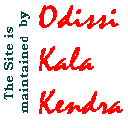Odissi,
which originated in Orissa situated at the Bay of
Bengal in India, is the highly inspired, impassioned,
ecstatic and sensuous form of dance. It was performed
in the temples of Orissa as a religious rite and
offering by the Devadasis known as Maharis. Thus,
Odissi is a rich and generous cultural gift of the
land well known for its dedication to religion and
arts.
The
people of this land raised magnificent temples, each
erected as an act of prayer and embellished by the
skills of master craftsmen, sculptors and architects.
They belong to the "enchanted millennium of
classical art". Restrained, relaxed, rhythmic
and real, they portray an unbroken sequenc
e of a
dance recital to the accompaniment of music. These
became the centre of art and culture and it was here
that Odissi, one of India's scintillating dance forms
was born, nurtured and nourished.
For
centuries together, the magnificent temples at
Bhubaneshwar, Puri and Kornark remained the focal
point of religion and art. The Fundamental principal
and purposes of a temple and an art are the same.
They compliment each other.
The
temple walls, studded with sculptures of dancing
poses, singing stances and mithunas tell of the
Golden age of Indian Classical Dances, music and
sculpture. The poses of the figures carved on the
temple are based upon dance poses and dance rhythm to
evoke specific moods. Complex groups of images follow
a rhythmic pattern across the wall surfaces like the
intricate beat of Indian drums in development of a
classical raga.
Rooted
deeply in traditions and rituals the dance is very
old. The technique, style, its stages, the repetoire
and finale were almost amorphous and we cannot say
how exactly the Maharis had danced it in the past. So
the Maharis and the Achariyas adapted the existing
format of Bharatha Natyam along with the sculpures on
the walls of the temples to the present form of new
Odissi. This is a well established and codified
classical dance form of India, a dance of love,
delight, and intense passion, lyrical, pure, divine
and human, all rolled into one.
It
commences with the invocation to Gods and salutations
to the Mother Earth, the Elephant headed God
Vigneshwara, remover of all obstacles. Here the
spectators are ushered into a facianting world of
mime, music and motives reflecting sculpture stances.
The
Introductory piece is a fine example of short but
sweet piece of pure and expressional dance. The
prelude ends with the recitation of a shloga in
Sanscrit or Orissi and its fine interpretation by the
dancer, reflecting a delicate balance between pure
dance, expressional dance and a combination and
acting and dance. Then follows the Pallavi which
corresponds to the Jateeswaram. It is highly lyrical
which familiarises us with the mood of the dance.
Usually it's from the Gita Govinda, underlining the
passionate love of Krishna for the cowherdess Radha.
The expressional number is laced with some very fast
dance sequences. It is a very evocative item full of
fine sculpuresque stances, scintilating footwork and
a variety of dance patterns demanding a great command
and technique on the part of the dancer and finally
leads to the climax which is called Moksha.
This
corresponds to Tillana and litterally means
salvation, liberation, release or deliverance. Here
the dance and the dancer become one culminating into
an all inclusive awareness, a fathomless deep
consiousness where all thoughts are dissolved and
fused into perfect harmony and equilibrium.
Odissi
presents a fine synthesiss of lasya (feminity) and
Tandava aspects of the Indian Classical Dance. The
dancer very efficiently changers from one to the
other according to the need of the expressional
number, rythmic syllables and abhinaya. The dance
numbers are either in Sanskrit or Orissi and the
music is a combination of Hindustani and Carnatic
classical styles.
The
performance and enjoyment of Odissi dance recital, so
tender and vigorous, intensly erotic and devotional,
moving in sculpturesque poses, is an unique
experience; a constant source of delight and
inspiration. It transcends all the limits of
communication leading to a rich aesthetic and
spirtual experience. Like its source, the all time
Gita Govinda of Jayadeva, Odissi is also for ever and
it is for all the classes and masses.
